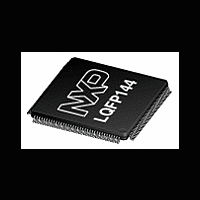LH75401_LH75411_N NXP Semiconductors, LH75401_LH75411_N Datasheet - Page 29

LH75401_LH75411_N
Manufacturer Part Number
LH75401_LH75411_N
Description
The NXP BlueStreak LH75401/LH75411 family consists of two low-cost 16/32-bit System-on-Chip (SoC) devices
Manufacturer
NXP Semiconductors
Datasheet
1.LH75401_LH75411_N.pdf
(63 pages)
System-on-Chip
CAN 2.0B FEATURES
• Full compliance with 2.0A and 2.0B Bosch
• Supports 11-bit and 29-bit identifiers
• Supports bit rates up to 1Mbit/s
• 64-byte receive FIFO
• Software-driven bit-rate detection for hot plug-in
• Single-shot transmission option
• Acceptance filtering
• Listen Only Mode
• Reception of ‘own’ messages
• Error interrupt generated for each CAN bus error
• Arbitration-lost interrupt with record of bit position
• Read/write error counters
• Last error register
• Programmable error-limit warning.
Analog-to-Digital Converter (ADC)/
Brownout Detector
nects as a slave to the APB. The ADC block consists of
an 8-channel, 10-bit Analog-to-Digital Converter with
integrated Touch Screen Controller. The complete
Touch Screen interface is achieved by combining the
front-end biasing, control circuitry with analog-to-digital
conversion, reference generation, and digital control.
clock derived from the system clock. The clock drives
the measurement sequencer and the successive-
approximation circuitry.
out Detector is an asynchronous comparator that com-
pares a divided version of the 3.3 V supply and a
bandgap-derived reference voltage. If the supply dips
below a Trip point, the Brownout Detector sets a status
register bit. The status bit is wired to the VIC and can
interrupt the processor core. This allows the Host Con-
troller to warn users of an impending shutdown and may
provide the ADC with sufficient time to save its state.
ADC/BROWNOUT DETECTOR FEATURES
• 10-bit fully differential Successive Approximation
• 8-channel multiplexer for routing user-selected inputs
• 16-entry × 16-bit-wide FIFO that holds the 10-bit
• Front bias-and-control network for Touch Screen
Preliminary data sheet
specifications
support
Register (SAR) with integrated sample/hold
to the ADC in Single Ended and Differential Modes
ADC output and a 4-bit tag number
interface and support functions compatible with indus-
try-standard 4- and 5-wire touch-sensitive panels
The ADC is an AMBA-compliant peripheral that con-
The ADC also has a programmable measurement
The ADC includes a Brownout Detector. The Brown-
NXP Semiconductors
Rev. 01 — 16 July 2007
• Touch-pressure sensing circuits
• Pen-down sensing circuit and interrupt generator
• Voltage-reference generator that is independently
• Conversion automation function to minimize control-
• Brownout Detector.
Synchronous Serial Port (SSP)
serial communication with slave peripheral devices that
have a Motorola SPI, National Semiconductor
Microwire, or Texas Instruments DSP-compatible
Synchronous Serial Interface (SSI).
data received from a peripheral device. The transmit and
receive paths are buffered with internal FIFO memories.
These memories store eight 16-bit values independently
in both transmit and receive modes. During transmission:
• Data writes to the transmit FIFO via the APB
• The transmit data is queued for parallel-to-serial
• The transmit logic formats the data into the appropri-
SSP FEATURES
• SSI in Master Only Mode. The SSP performs serial
• Two 16-bit-wide, 8-entry-deep FIFOs, one for data
• Supports interrupt-driven data transfers that are
• Programmable clock bit rate.
• Programmable data frame size, from 4 to 16 bits long,
• Four interrupts, each of which can be individually
• Loopback Test Mode.
controlled
ler interrupt overhead
interface.
conversion onto the transmit interface.
ate frame type:
communications as a master device in one of three
modes:
transmission and one for data reception.
greater than the FIFO watermark.
depending on the size of data programmed. Each
frame transmits starting with the most-significant bit.
enabled or disabled using the SSP Control Register
bits. A combined interrupt is also generated as an
OR function of the individual interrupt requests.
The SSP is a master-only interface for synchronous
The SSP performs serial-to-parallel conversion on
– Motorola SPI
– National Semiconductor Microwire
– Texas Instruments DSP-compatible SSI.
– Motorola SPI
– Texas Instruments DSP-compatible synchronous
– National Semiconductor Microwire.
serial interface
LH75401/LH75411
29














